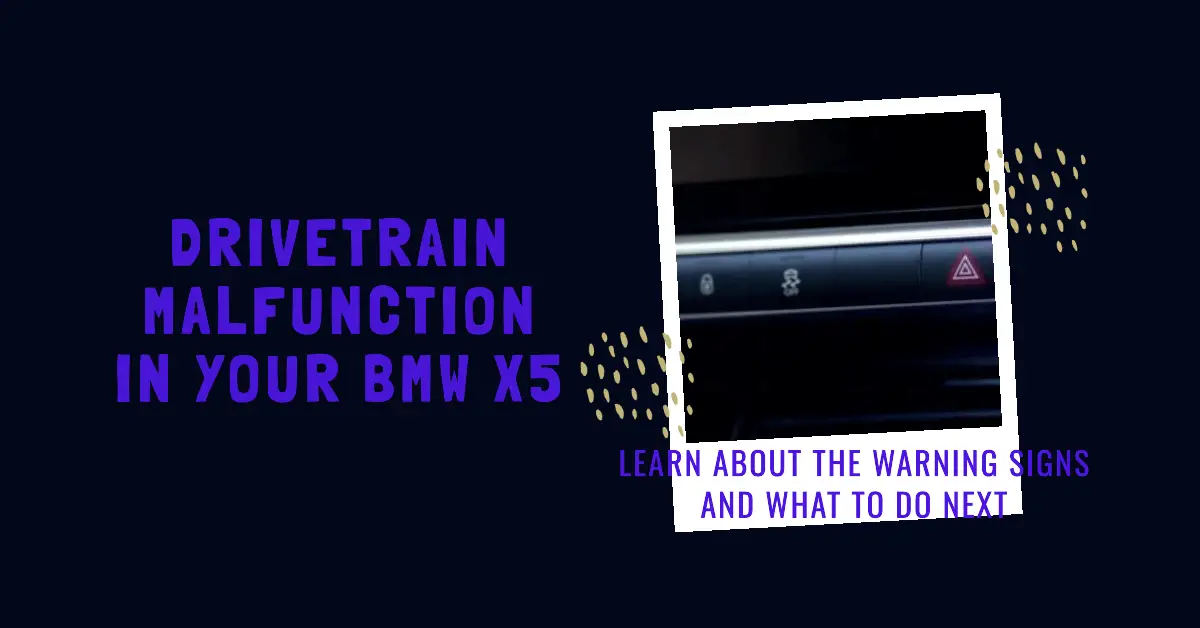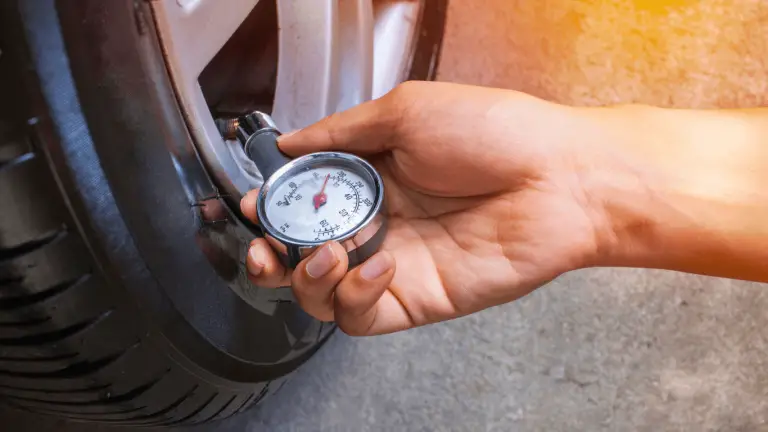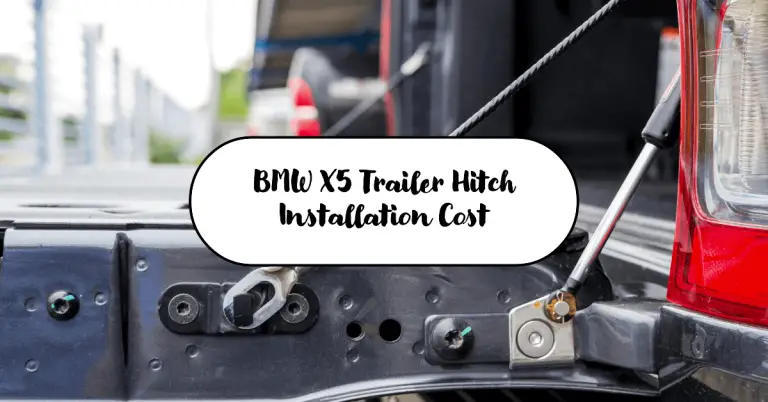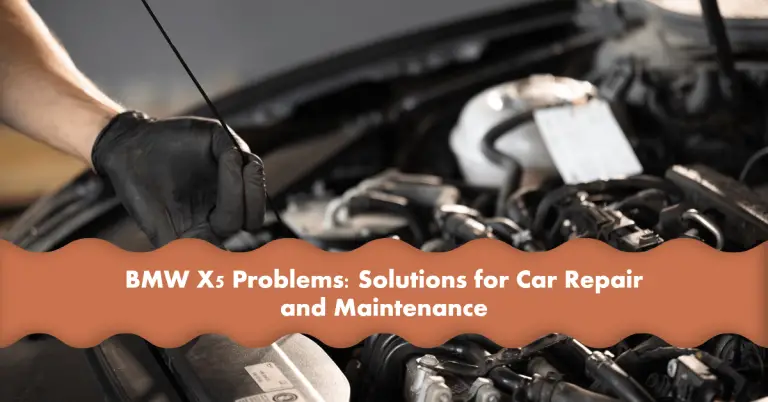BMW X5 Drivetrain Malfunction: Causes, Diagnosis & Repair
Have you suddenly gotten a “Drivetrain Malfunction” warning light in your BMW X5? Does it feel like your X5 is slipping, jerking, or just not driving right? If so, there’s likely an issue with one or more components in your BMW’s drivetrain – the system that delivers power to the wheels. Don’t panic, many drivetrain problems can be fixed if properly diagnosed and repaired. This comprehensive guide will walk you through the possible causes, how to diagnose the specific problem, and the steps for fixing BMW X5 drivetrain malfunctions. We’ll cover everything from sensor faults and transmission issues, to driveshaft and differential repairs. Read on to get your BMW X5 back to smoothly driving down the open road once again!
What is the Drivetrain in a BMW X5?
Before jumping into the possible issues, let’s quickly review what makes up the drivetrain in a BMW X5 and how it works:
- Engine – The turbocharged gas or diesel engine provides the power and torque to propel the vehicle. Common BMW X5 engines are the 3.0L twin-turbo I6, 4.4L twin-turbo V8, and 3.0L turbo diesel I6.
- Transmission – Changes gears and transfers engine torque to the driveshaft. The X5 uses ZF 8-speed automatic transmissions.
- Driveshaft – The long shaft running under the vehicle that transmits power from the transmission to the rear differential and axles. Contains universal joints and support bearings.
- Transfer Case – Splits torque between the front and rear axles on AWD models. Contains gears and actuators to control torque distribution.
- Differential -Divides torque evenly between the left and right wheels. Contains gear sets allowing wheels to rotate at different speeds when turning.
- Axles/CV Joints – Transfer torque from differential to front and rear wheels. Constant velocity (CV) joints allow axles to flex when steering and articulating.
This drivetrain layout allows engine power to smoothly reach all four wheels through various components working together. Now let’s look at what can go wrong.
Common Causes of BMW X5 Drivetrain Malfunctions
There are a number of components in the BMW X5 drivetrain that can develop faults and cause drivability issues:
Sensor Failure
Various sensors monitor drivetrain operation and send input to the vehicle computer. Common problem sensors include:
- Crankshaft Position Sensor – Reports engine RPM and crank position to the computer. Failure causes stalling, no starts, and power loss.
- Camshaft Position Sensor – Tracks camshaft speed and timing. Faults can lead to very rough running or no starts.
- Wheel Speed Sensors – Measure how fast each wheel is rotating. Damaged sensors cause ABS, stability, and 4×4 system problems.
- Output Speed Sensor – Monitors transmission output shaft speed. Defective sensors lead to shifting issues.
Replacing failed drivetrain sensors often fixes drivability problems and warning lights. They deteriorate over time from heat, dirt, and wear.
Transmission Failure
As one of the most complex drivetrain components, BMW’s 8-speed automatic transmissions are prone to various failures:
- Mechatronic Unit – Hydraulic valve body and control module in one unit. Electrical faults lead to rough shifting, no shifts, or limp mode.
- Solenoid Valves – Control transmission fluid pressure for shifting. Jammed or leaky solenoids cause delayed, hard shifts.
- Clutch Packs – Multiple clutch discs engage gears in transmission. Worn clutch materials lead to slipping and loss of power.
- Seals and Gaskets – Leaking seals can cause low fluid levels allowing transmission damage. External leaks indicate seal failure.
- Torque Converter – Links engine to transmission input shaft. Bad bearings or lockup mechanisms cause vibration and power loss.
BMW automatic transmissions are very complex, so repairs often require a specialist. Rebuilding or replacing the transmission may be needed in severe cases.
Driveshaft Failure
As the main connection between transmission and differential, BMW X5 driveshafts endure a lot of stress and wear:
- Center Support Bearing – Supports driveshaft between transmission and rear axle. Excessive play causes vibration under acceleration.
- Universal Joints – Allow driveshaft to flex. Dry, worn u-joints lead to clunking when changing speeds.
- Front Flex Disc – Dampens driveline vibrations from engine. Cracked or separated discs cause severe shuddering.
- Rear Guibo – Flex coupling absorbing vibrations at rear axle. Hardened, cracked guibos lead to clunking during speed changes.
- Driveshaft – Dented or bent driveshafts cause bad vibration and imbalance. Requires replacement.
Inspection and replacement of any damaged driveshaft components is needed to cure vibrations, noise, and loss of power.
Transfer Case Failure
On BMW X5 models with AWD, the transfer case splits engine torque between front and rear axles. Some issues include:
- Transfer Case Actuator – Electric motor controls torque split by changing gearing. Failure leads to AWD system malfunction.
- Control Module – Manages AWD system components and torque distribution. Electrical faults cause warning lights and disable AWD.
- Fluid Leaks – Low transfer case oil causes premature wear and failure. External leaks indicate loose seals.
- Shift Forks – Engage transfer case modes – 2WD high, AWD high, low range. Bent forks prevent shifting into modes.
Resealing or replacing the transfer case actuator and controller restores proper AWD functionality and eliminates drivetrain malfunction symptoms.
Differential Breakdown
The rear differential divides torque evenly between the rear wheels. Problems include:
- Gears – Worn, chipped, or burnt gear teeth lead to whining and grinding noises from the differential. Total failure prevents power getting to wheels.
- Bearings – Support and align the differential gears. Worn bearings cause play in the gears creating noise and eventual failure.
- Actuators – Control limited slip differentials on some models. Actuator failure disables torque vectoring functions.
- Fluid Leaks – Low oil causes accelerated wear and differential failure. Look for external leaks.
Rebuilding or replacing a damaged differential is required to restore proper torque delivery to the rear wheels.
Now that you know the main components that can cause BMW X5 drivetrain malfunctions, let’s cover how to diagnose the specific problem.
Diagnosing BMW X5 Drivetrain Problems
Diagnosing drivetrain issues involves reading fault codes, noticing symptoms during driving, and inspecting components:
Retrieve Diagnostic Trouble Codes
Connecting an OBD2 scanner tool and reading BMW drivetrain fault codes is the first step in diagnosis. Codes indicate issues in certain systems like:
- P0700-P0799 – Transmission codes point to specific transmission components – clutches, gears, valves, solenoids, etc.
- P1000-P1999 – Engine and emissions codes can indicate drivetrain problems indirectly caused by engine issues.
- C1111 – Differential actuator failure directly indicates rear differential issues.
- U0415 – Invalid data from transfer case control module signals transfer case faults.
Codes provide a great starting point to identify the source of the drivetrain malfunction.
Notice Symptoms While Driving
Pay attention to any odd behaviors from the drivetrain when accelerating and changing speeds:
- Vibration – Usually caused by an out of balance driveshaft, bad differential bearings, or transfer case issues. Vibrations increase with speed.
- Slipping – Transmission is not fully engaging gears due to low fluid, worn clutches, or faulty solenoids. Acceleration lacks power.
- Jerking or Bucking – Transmission harshly engages or disengages gears due to low fluid pressure or faulty valves.
- Noise – Whining, grinding, or clunking noises point to issues in the differential or driveline joints.
- Delayed Engagement – Gears are slow to engage from a stop or when shifting. Indicates transmission or transfer case problems.
- Fluid Leaks -inspect undercarriage for red transmission fluid, brown differential oil, or black transfer case oil.
Test driving and noticing any unusual behaviors helps narrow down problem areas.
Visually Inspect Components
Look closely along the full drivetrain for any external damage or wear:
- Check for loose driveshaft center support bearing allowing driveshaft to wobble excessively.
- Look for cracked, separated, or missing driveshaft flex disc or Guibo coupler.
- Ensure driveshaft is straight without any dents or buckling.
- Transmission case and bell housing should be free of cracks and holes.
- Inspect for signs of fluid leaks near gaskets and seals.
- Transfer case should be securely mounted with no looseness or leaks.
- Check axle boots for tears or grease leakage indicating damaged CV joints.
Closely looking over components can reveal external damage and issues that lead to drivetrain faults.
By pulling diagnostic codes, test driving, and visual inspection, you can get a clear picture of the root cause of drivetrain malfunctions. Next we’ll cover how to fix some common issues.
Repairing BMW X5 Drivetrain Problems
Once the source of the drivetrain fault is diagnosed, repairs can be made. Here are some common fixes:
Sensor Replacement
Defective drivetrain sensors are a simple fix. For example:
- Crankshaft position sensors are located behind the harmonic balancer. Remove the wiring connector and bolt holding it in place. Install the new sensor, reconnect wiring, and clear any codes.
- Wheel speed sensors unbolt from the suspension or axle hub. Remove clip from wiring harness and fit the new sensor in place.
- Output speed sensor unscrews from the transmission case. Insert the replacement sensor with a new O-ring seal and tighten securely.
Faulty drivetrain sensors can be swapped out easily in an hour or two. Programmers can reset and recalibrate the new sensors in most cases.
Transmission Repair
Transmission issues vary greatly in complexity and repair cost:
- Solenoid replacement – Trans shop removes valve body to access solenoids. Damaged solenoids are replaced and valve body reinstalled.
- Clutch repair – Requires transmission disassembly to access clutch packs. Shop replaces worn clutch discs and steels plates to restore grip.
- Seal replacement – Usually done when transmission is removed for other repairs. All seals and gaskets get replaced at once.
- Replacement – If internal parts are too extensively damaged, the most cost effective repair is replacing the transmission entirely with a new or remanufactured unit.
Expect to pay $2000+ for BMW X5 transmission repairs at a specialty transmission shop. It requires highly skilled technicians.
Driveshaft & Axle Repair
Driveshaft repairs involve replacing individual components:
- Center support bearing – Lower rear exhaust and remove driveshaft to press out old bearing. Press in the new bearing.
- Universal joints – Mechanic will remove driveshaft and press out the worn u-joints to install new ones.
- Flex discs – Remove driveshaft and pry off clamps to replace damaged flex discs with new ones.
For axle repairs:
- CV axle shafts – Unbolt axle shaft from differential side to slide out of wheel hub. Install new axle shaft.
- CV joints – Bad inner or outer joints require replacing whole axle shaft assembly.
Expect to pay $500-800 for BMW X5 driveshaft and axle repairs. U-joints alone can run $300+ in labor to press out and replace.
Transfer Case or Differential Rebuild
For major transfer case or differential repairs, the best solution is a professional rebuild:
Transfer case
- Shop will disassemble unit, inspecting gears, actuators, shift components.
- Damaged parts are replaced and new seals installed throughout.
- Transfer case is reassembled, filled with fluid, and tested.
Differential
- Differential is fully disassembled to check ring/pinion gears, bearings, actuators.
- Technician will replace any worn or damaged parts.
- Unit is carefully reassembled to precise specifications. New fluid added.
Parts plus labor for transfer case or differential rebuild is around $1200-2000 at a drivetrain specialty shop. Well worth it to restore proper 4×4 system or rear end function.
While some drivetrain repairs like sensors are DIY-friendly, it’s best to use a professional mechanic experienced in BMW drivetrain components for major transmission, transfer case, and differential repairs. Their expertise can get your X5 driving smoothly again faster and more reliably.
Get Back to Normal Driving in Your BMW X5
Dealing with a drivetrain malfunction warning light or odd driving behavior in your BMW X5 can be stressful. But hopefully understanding the common failure points, diagnostic process, and repair options gives you confidence in getting your vehicle repaired properly. With the right diagnosis and parts replacement, your X5 will be smoothly delivering power to the road again in no time. Just be diligent with preventive maintenance on all drivetrain components to maximize their longevity. Happy and safe motoring!







